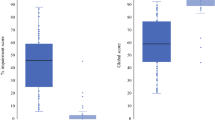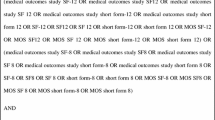Abstract
Purpose
The purpose of this instrument development project was to create a self-report tool to evaluate arm lymphedema and associated symptoms in breast cancer survivors.
Methods
The Lymphedema Symptom Intensity and Distress Survey-Arm (LSIDS-A) was developed and tested in three phases: phase 1—literature review and expert panel; phase 2—preliminary validation; and phase 3—final validation.
Results
Phase 1: The most common symptoms experienced by breast cancer survivors with lymphedema were identified. A 52-item scale was developed. Phase 2: 128 community-dwelling breast cancer survivors (64 with lymphedema, 64 without lymphedema) completed the LSIDS-A. Feedback from the participants was that the format was “clear” and “made sense”; therefore, the response structure was left intact. Sixteen items were deleted leaving a 36-item revised instrument. Phase 3: Subsequent testing in a total sample of 236 breast cancer survivors with lymphedema was undertaken. The Cronbach’s alpha reliability values for the overall intensity and distress scores were 0.93 and 0.94, respectively. The Kuder-Richardson values ranged from 0.66 to 0.92. Divergent validity evaluated against Marlowe-Crowne Social Desirebility Scale overall was acceptable (intensity, r s = 0.08; distress, r s = −0.12). Convergent validity was acceptable as tested with multiple instruments (e.g., Functional Assessment of Cancer Therapy-Breast +4, overall intensity r s = −0.44, overall distress r s = −.48)
Conclusions
The 30-item LSIDS-A is a valid and reliable instrument that can be used to assess arm lymphedema and its associated symptoms.

Similar content being viewed by others
References
Bulley C, Coutts F, Blyth C, Jack W, Chetty U, Barber M, Tan CW (2014) A Morbidity Screening Tool for identifying fatigue, pain, upper limb dysfunction and lymphedema after breast cancer treatment: a validity study. Eur J Oncol Nurs 18(2):218–227. doi:10.1016/j.ejon.2013.10.006
Deng J, Ridner SH, Murphy BA, Dietrich MS (2012) Preliminary development of a lymphedema symptom assessment scale for patients with head and neck cancer. Support Care Cancer 20(8):1911–1918. doi:10.1007/s00520-011-1294-6
Ridner SH, Dietrich MS, Kidd N (2011) Breast cancer treatment-related lymphedema self-care: education, practices, symptoms, and quality of life. Support Care Cancer 19(5):631–637. doi:10.1007/s00520-010-0870-5
Weissleder H, Schuchhardt C (2008) Lymphedema: Diagnosis and therapy, 4th edn. Viavital, Berlin
Szuba A, Rockson SG (1998) Lymphedema: Classification, diagnosis and therapy. Vasc Med 3(2):145–156
Ridner SH, Fu MR, Wanchai A, Stewart BR, Armer JM, Cormier JN (2012) Self-management of Lymphedema: A systematic review of the literature from 2004 to 2011. Nurs Res 61(4):291–299. doi:10.1097/NNR.0b013e31824f82b2
International Society of Lymphology (2003) The Diagnosis and Treatment of Peripheral Lymphedema: Consensus document of the International Society of Lymphology. Lymphology 36:84–91
Ridner SH (2005) Quality of life and a symptom cluster associated with breast cancer treatment-related lymphedema. Support Care Cancer 13(11):904–911. doi:10.1007/s00520-005-0810-y
Ridner SH, Montgomery LD, Hepworth JT, Stewart BR, Armer JM (2007) Comparison of upper limb volume measurement techniques and arm symptoms between healthy volunteers and individuals with known lymphedema. Lymphology 40(1):35–46
Woods M (1993) Patients' perceptions of breast-cancer-related lymphoedema. Eur J Cancer Care (Engl) 2(3):125–128. doi:10.1111/j.1365-2354.1993.tb00181.x
Ridner SH, Bonner CM, Deng J, Sinclair VG (2012) Voices From the Shadows: Living with lymphedema. Cancer Nurs 35(1):E18–E26. doi:10.1097/NCC.0b013e31821404c0
Ridner SH, Sinclair V, Deng J, Bonner CM, Kidd N, Dietrich MS (2012) Breast Cancer Survivors with Lymphedema: Glimpses of their daily lives. Clin J Oncol Nurs 16(6):609–614. doi:10.1188/12.CJON. 609-614
Armer JM, Radina ME, Porock D, Culbertson SD (2003) Predicting breast cancer-related lymphedema using self-reported symptoms. Nurs Res 52(6):370–379
Brown JC, Kumar A, Cheville AL, Tchou JC, Troxel AB, Harris SR, Schmitz KH (2014) Association between lymphedema self-care adherence and lymphedema outcomes among women with breast cancer-related lymphedema. Am J Phys Med Rehabil. doi:10.1097/PHM.0000000000000178
Norman SA, Miller LT, Erikson HB, Norman MF, McCorkle R (2001) Development and validation of a telephone questionnaire to characterize lymphedema in women treated for breast cancer. Phys Ther 81(6):1192–1205
Coster S, Poole K, Fallowfield LJ (2001) The validation of a quality of life scale to assess the impact of arm morbidity in breast cancer patients post-operatively. Breast Cancer Res Treat 68(3):273–282
Lenz ER, Pugh LC, Milligan RA, Gift A, Suppe F (1997) The middle-range theory of unpleasant symptoms: an update. ANS Adv Nurs Sci 19(3):14–27
Lenz ER, Suppe F, Gift AG, Pugh LC, Milligan RA (1995) Collaborative development of middle-range nursing theories: toward a theory of unpleasant symptoms. ANS Adv Nurs Sci 17(3):1–13
Ridner SH, Murphy B, Deng J, Kidd N, Galford E, Bonner C, Bond SM, Dietrich MS (2012) A randomized clinical trial comparing advanced pneumatic truncal, chest, and arm treatment to arm treatment only in self-care of arm lymphedema. Breast Cancer Res Treat 131(1):147–158. doi:10.1007/s10549-011-1795-5
Ridner SH, Poage-Hooper E, Kanar C, Doersam JK, Bond SM, Dietrich MS (2013) A pilot randomized trial evaluating low-level laser therapy as an alternative treatment to manual lymphatic drainage for breast cancer-related lymphedema. Oncol Nurs Forum 40(4):383–393. doi:10.1188/13.ONF. 383-393
Cella D (1997) FACIT Manual: Manual of the Functional Assessment of Chronic Illness Therapy (FACIT) measurement system. Center on Outcomes, Research and Education
Launois R, Mègnigbêto A, Le Lay K, Alliot F (2001) CN5: A Specific Quality Of Life Scale In Upper Limb Lymphoedema: The Ull-27 Questionnaire. Value Health 4(6):407–408
Seltzer GB, Granger CV, Wineberg DE (1982) Functional Assessment: Bridge between family and rehabilitation medicine within an ambulatory practice. Arch Phys Med Rehabil 63(10):453
Millard RW (1989) The Functional Assessment Screening Questionnaire: Application for evaluating pain-related disability. Arch Phys Med Rehabil 70(4):303–307
Radloff LS (1977) The CES-D scale: A self-report depression scale for research in the general population. Appl Psychol Meas 1(3):385
Curran SL, Andrykowski MA, Studts JL (1995) Short form of the Profile of Mood States (POMS-SF): Psychometric information. Psychol Assess 7(1):80–83
Shacham S (1983) A shortened version of the Profile of Mood States. J Pers Assess 47(3):305–306
Crowne DP, Marlowe D (1960) A new scale of social desirability independent of psychopathology. J Consult Psychol 24(4):349–354
Goldfried MR (1964) A cross-validation of the Marlowe-Crowne Social Desirability Scale items. J Soc Psychol 64(1):137–145
Funding
Development of the LSIDS-A was supported by the following: (1) a grant from the American Cancer Society MRSG-07-012-01-CPPB; (2) a grant from the Oncology Nursing Society Foundation; (3) a grant from the National Center for Research Resources National Institutes of Health UL 1RR024975; (4) a National Research Service Award #1 F31 NR07854-02; (5) a Sigma Theta Tau Iota Chapter grant; (6) a Vanderbilt University Dissertation Enhancement Award; (7) a Vanderbilt School of Nursing Postdoctoral Award; (8) Tactile Systems Technology, Incorporated, 1331 Tyler Street NE, Suite 200, Minneapolis, MN 55413; and (9) The Martha Rivers Ingram Chair in Nursing at Vanderbilt University.
Conflict of interest
The authors have no other conflicts to disclose.
Author information
Authors and Affiliations
Corresponding author
Rights and permissions
About this article
Cite this article
Ridner, S.H., Dietrich, M.S. Development and validation of the Lymphedema Symptom and Intensity Survey-Arm. Support Care Cancer 23, 3103–3112 (2015). https://doi.org/10.1007/s00520-015-2684-y
Received:
Accepted:
Published:
Issue Date:
DOI: https://doi.org/10.1007/s00520-015-2684-y




